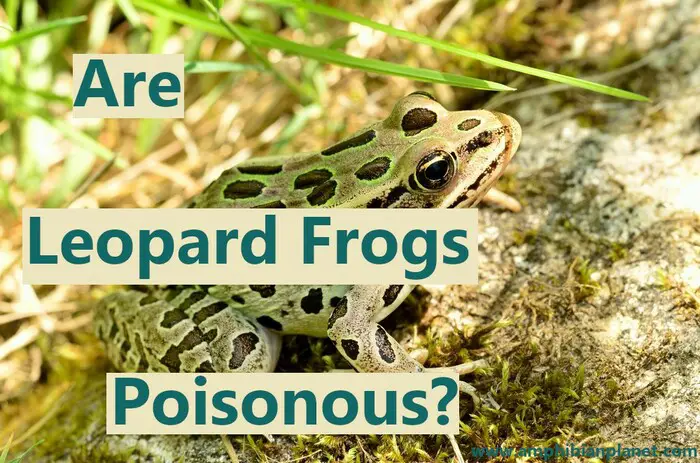Leopard frogs are small frogs found across much of the Northern part of North America. These frogs vary in color between species, but can easily be identified by their dark spots which form a leopard-like pattern. But are leopard frogs poisonous?
Leopard frogs are not poisonous. They do not produce any skin toxins and are generally harmless to humans, dogs, cats, or any other pets. The only real threat they pose is that, like many amphibians, they can be carriers of salmonella bacteria, which can be harmful to humans and pets.
To be safe, do not handle leopard frogs (or any other amphibians) unless necessary.
When you do handle them, take a few safety precautions (such as wearing protective gloves) and remember to wash your hands with antibacterial soap after.
Do not touch your face or put anything into your mouth before washing your hands.
Leopard Frogs Do Not Produce Skin Toxins
However, this does not mean leopard frogs are totally defenseless when it comes to fending off predators. They have other ways to protect themselves.
Leopard Frogs Do Not Have Venom
If you are like most people, you have probably (at least once) used the words “venomous” and “poisonous” interchangeably. But you should know that there is a significant difference between these two terms.
Sure, they both refer to toxins that could be harmful to us, but the difference lies in how these toxins are delivered.
Generally;
- If an animal has to bite or sting you to inject its toxins, it is venomous (think rattlesnakes)
- If an animal secretes its toxin on its skin, and you absorb that toxin when you touch the animal, it is poisonous (think poison dart frogs)
In other words, venom is actively injected usually through fangs or stings. Poison on the other hand is passively delivered – an animal releases toxins on its skin, which are then absorbed by animals (or humans) that come in contact with it.

Leopard frogs do not secrete toxins on their skin and neither do they have the ability to inject any toxins. For this reason, they are not venomous or poisonous.
How Do Leopard Frogs Defend Themselves?
Since leopard frogs do not have any toxins, they may seem defenseless when it comes to fending off hungry predators. However, they have a few tricks to keep predators away.
As the first line of defense, leopard frogs have a coloration that helps them camouflage or blend into the leaves and other debris in their environments, escaping the notice of most predators.
However, sometimes camouflage alone is not enough, so leopard frogs also have very quick responses. If they see a predator getting too close, they can use their powerful hind legs to quickly leap into the water (they can hop up to 3 feet) and swim away to escape.
If they are not close to a body of water, they can make quick erratic hops to confuse and distract the predator, giving them enough time to escape.
Some Leopard Frogs May Mimic Poisonous Pickerel Frogs
Leopard frogs look very similar to pickerel frogs. Although leopard frogs lack toxins, pickerel frogs can produce toxic skin secretions that are irritating to predators.

The main way to tell leopard frogs apart from pickerel frogs is by the spots that run down their back.
In general,
- Pickerel frogs have square-shaped spots in rows,
- Leopard frogs have rounded spots in a more random pattern.
However, in areas where these two frog species co-occur, leopard frogs have been found to have squarish spots, like those of pickerel frogs.
This has led some scientists to theorize that this striking similarity in appearance is a form of defensive mimicry.
Defensive mimicry is when animals can avoid predators by deceiving them into treating them as something else. This includes sounding, smelling, acting, or otherwise resembling another animal.
For example, a harmless insect that looks, sounds, and acts like a bee may be avoided by predators that mistake it for a bee.
In the case of leopard frogs, their striking similarity to toxic pickerel frogs means some predators may have a hard time distinguishing them from their toxic look-alikes and avoid them altogether. In this way, the resemblance acts as a sort of defense.
Are Leopard Frogs Dangerous to Humans?
Since leopard frogs do not secrete any toxins, they are generally harmless to humans. That being said, it is important to note that nearly all salamanders and frogs (including leopard frogs) can carry salmonella bacteria, which can be harmful to humans.
Leopard frogs can carry salmonella bacteria in their digestive tract and excrete it in their waste. The bacteria do not cause any illness in the frog – so a leopard frog carrying salmonella bacteria can look clean and healthy, but the bacteria can be transmitted to humans.

Humans can be exposed to salmonella by direct or indirect contact with a frog, its waste, or anything the frog came in contact with. (For example, you touch a leopard frog or its droppings, then stick your fingers into your mouth without first washing your hands).
Exposure to salmonella can cause an infection called Salmonellosis which is characterized by stomach cramps, diarrhea, fever, nausea, and sometimes vomiting. The infection is usually mild and non-life-threatening – but in some cases, the bacteria can get into the bloodstream leading to serious illness.
For this reason, it is advisable to avoid handling leopard frogs unless when necessary. Even though the frog is not toxic, it may be carrying bacteria that can make you sick.
Are Leopard Frogs Poisonous to Dogs or Cats?
Leopard frogs do not have any toxins so they are typically harmless to dogs, cats, or other pets, even if eaten. However, as mentioned earlier leopard frogs can carry salmonella bacteria so a dog or cat that mouths, bites or eats a leopard frog may consume the bacteria and develop an infection.
Also, frogs can carry tapeworms and other parasites. This means if a dog eats a leopard frog, it may also consume parasites and develop a parasitic infection.
For this reason, it’s a good idea to keep your pets away from any frogs, even if they are not toxic.
Safety Precautions to Take When Handling Leopard Frogs
It is generally not a good idea to handle leopard frogs or any other amphibians. This is because they have very sensitive permeable skin that allows water and other substances to pass through it.
Oils, salts, lotions, and other substances on your hands can pass right through their skin and end up inside their bodies.
For this reason, it’s advisable to observe leopard frogs from a distance without physically touching them.
If you ever need to handle a leopard frog (such as moving it off a road), take the following precautions to protect both you and the animal.
Before Handling
Make sure your hands are thoroughly washed off and are very clean. Not just clean from dirt, but also from any soap residue, lotions, or other substances that could harm the frog.
Even better, you could wear vinyl or latex gloves. Wearing gloves will not only prevent you from coming in contact with bacteria that may be on the frogs’ skin but will also protect the frog from harmful substances you may have on your hands.
When Handling
- Keep the frog away from your eyes nose and mouth and, be very careful not to touch your eyes, nose, or mouth.
- As you handle the frog, do it very gently and with care so you do not injure or stress the frog in any way.
Frogs should only be handled for a short time. Handling a frog too long can cause stress to the animal and dry out its skin.
What to Do After Handling
- Very thoroughly wash your hands with anti-bacterial soap under running water.
Even if you were wearing gloves, it is still a good idea to go the extra mile by washing your hands. As earlier mentioned, leopard frogs may carry bacteria that can be harmful so it’s best to protect yourself.
Before washing your hands, do not touch anything, especially not your face, and do not put anything in your mouth.
Frequently Asked Questions
How long do leopard frogs live? Leopard frogs typically live about 5 to 8 years in the wild. However, in captivity, they may be able to live much longer than that as most of their natural threats are eliminated.
What do leopard frogs eat? Like most frogs, leopard frogs are opportunistic carnivores. They eat worms, slugs, snails, spiders, centipedes, soft-bodied insects, and other invertebrates.
Can you keep a leopard frog as a pet? Leopard frogs are a popular pet among amphibian enthusiasts. They are relatively easy to care for but like any other pet, they need proper care and maintenance. The most common variety kept as a pet is the northern leopard frog.
Conclusion
Leopard frogs are beautiful amphibians that are unlikely to ever cause you any problems. They do not possess any toxins and are totally harmless when left alone.
The only danger they pose is that they can be carriers of salmonella bacteria which can make you sick. However, the risk of getting salmonella can be significantly reduced by practicing basic hygiene and taking a few simple precautions.
When left alone (or when handled with care), leopard frogs are nothing to ever be worried about.


